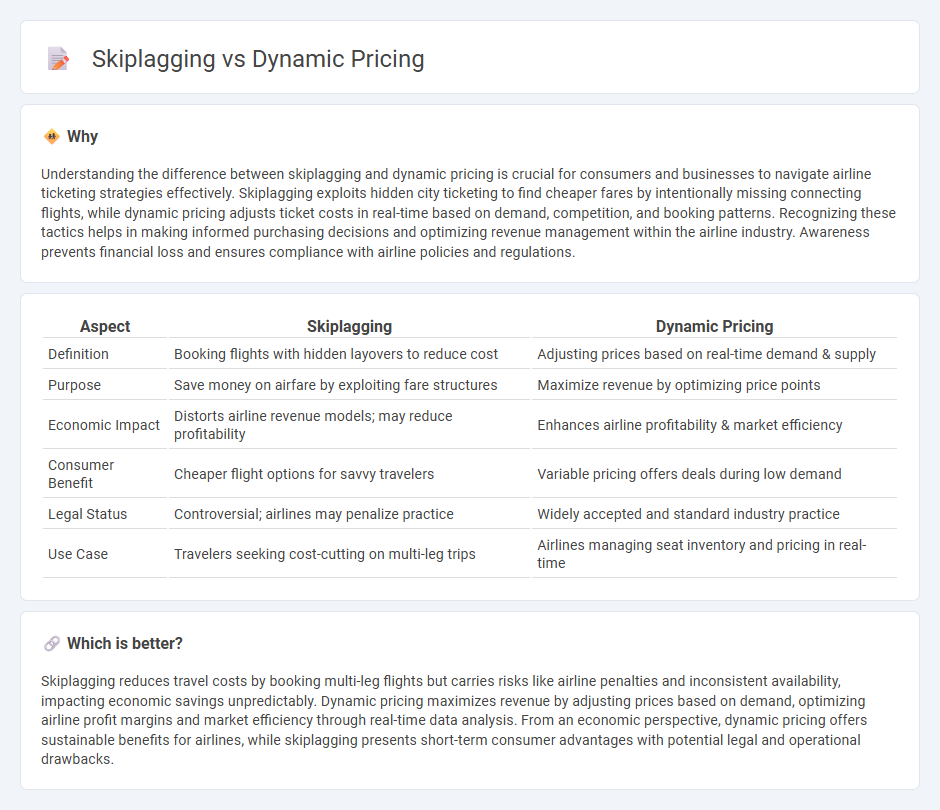
Skiplagging exploits hidden city ticketing to reduce airfare costs, while dynamic pricing adjusts flight prices in real-time based on demand and supply factors. Airlines employ advanced algorithms and big data analysis to implement dynamic pricing strategies, maximizing revenue through personalized fare variations. Discover the intricate dynamics shaping modern airline pricing models and their economic implications.
Why it is important
Understanding the difference between skiplagging and dynamic pricing is crucial for consumers and businesses to navigate airline ticketing strategies effectively. Skiplagging exploits hidden city ticketing to find cheaper fares by intentionally missing connecting flights, while dynamic pricing adjusts ticket costs in real-time based on demand, competition, and booking patterns. Recognizing these tactics helps in making informed purchasing decisions and optimizing revenue management within the airline industry. Awareness prevents financial loss and ensures compliance with airline policies and regulations.
Comparison Table
| Aspect | Skiplagging | Dynamic Pricing |
|---|---|---|
| Definition | Booking flights with hidden layovers to reduce cost | Adjusting prices based on real-time demand & supply |
| Purpose | Save money on airfare by exploiting fare structures | Maximize revenue by optimizing price points |
| Economic Impact | Distorts airline revenue models; may reduce profitability | Enhances airline profitability & market efficiency |
| Consumer Benefit | Cheaper flight options for savvy travelers | Variable pricing offers deals during low demand |
| Legal Status | Controversial; airlines may penalize practice | Widely accepted and standard industry practice |
| Use Case | Travelers seeking cost-cutting on multi-leg trips | Airlines managing seat inventory and pricing in real-time |
Which is better?
Skiplagging reduces travel costs by booking multi-leg flights but carries risks like airline penalties and inconsistent availability, impacting economic savings unpredictably. Dynamic pricing maximizes revenue by adjusting prices based on demand, optimizing airline profit margins and market efficiency through real-time data analysis. From an economic perspective, dynamic pricing offers sustainable benefits for airlines, while skiplagging presents short-term consumer advantages with potential legal and operational drawbacks.
Connection
Skiplagging exploits airline dynamic pricing models by booking hidden-city tickets, leveraging price discrepancies between connecting and direct flights. Airlines use dynamic pricing algorithms that adjust fares based on demand, competition, and booking patterns, inadvertently creating cheaper options on multi-leg routes. This interplay between Skiplagging and dynamic pricing impacts airline revenue management, prompting carriers to implement stricter fare rules and booking algorithms.
Key Terms
Price discrimination
Dynamic pricing employs algorithms to adjust prices in real-time based on demand, customer behavior, and market conditions, enabling sellers to maximize revenue through personalized price discrimination. Skiplagging exploits fare structures by booking multi-leg flights but using only the cheaper, hidden layover segments, often circumventing standard pricing models and disrupting traditional price discrimination strategies. Explore deeper insights into how dynamic pricing and skiplagging impact price discrimination and consumer spending patterns.
Arbitrage
Dynamic pricing leverages real-time market demand to adjust ticket prices, creating opportunities for arbitrage by purchasing low-cost seats before rates surge. Skiplagging exploits hidden city ticketing, booking flights with layovers at the intended destination to secure lower fares unfairly priced due to hub city routing. Explore the intricacies of arbitrage strategies in air travel to maximize savings and understand regulatory implications.
Consumer surplus
Dynamic pricing adjusts prices based on real-time demand and customer behavior, often reducing consumer surplus by capturing more willingness-to-pay. Skiplagging exploits hidden city ticketing to find lower fares, increasing consumer surplus by circumventing standard pricing models. Explore the impact of these strategies on travel savings and market efficiency for deeper insight.
Source and External Links
Dynamic Pricing: What Is It & How It Effects E-Commerce - Dynamic pricing is a strategy where prices adjust in real time based on demand, competition, and supply changes, frequently used by e-commerce businesses like Amazon to boost revenue and stay competitive.
What is Dynamic Pricing? - DealHub - Dynamic pricing fluctuates product or service prices according to real-time market conditions, leveraging data on inventory, competitors, and customer behavior to optimize revenue across industries including travel, events, and B2B sectors.
Dynamic pricing - Wikipedia - Dynamic pricing, also known as surge pricing or demand pricing, entails flexible prices that rise during peak demand and fall during low demand, applied across industries like hospitality and retail using algorithms based on market factors.
 dowidth.com
dowidth.com